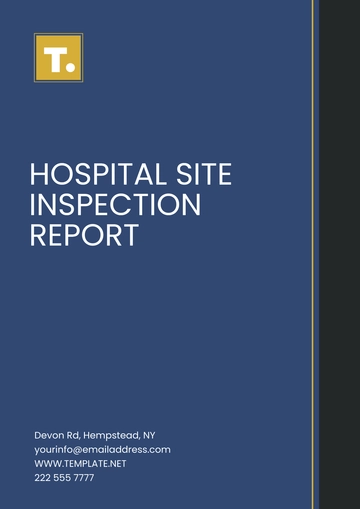Free Printable Industrial Site Visit Report

PRINTABLE INDUSTRIAL SITE VISIT REPORT
1. Introduction
This report summarizes the observations made during an industrial site visit to the manufacturing plant of [Your Company Name]. on December 10, 2054. The purpose of this visit was to assess the operational processes, evaluate safety protocols, review machinery conditions, and understand the efficiency of workforce management in their production facilities.
2. Objective of the Visit
To observe the efficiency and quality of manufacturing operations.
To evaluate the safety measures implemented for workers.
To inspect the condition and maintenance of machinery.
To assess the overall workforce productivity and training needs.
To identify environmental sustainability practices.
3. Scope of the Visit
The site visit focused on the following key areas:
Production Operations: Observing the flow of materials, assembly lines, and product quality control.
Safety Protocols: Examining the safety standards, use of protective equipment, and emergency preparedness.
Machinery and Equipment: Reviewing the maintenance schedules, condition of machinery, and overall operational efficiency.
Workforce Management: Assessing training programs, worker roles, and team dynamics.
Environmental Practices: Evaluating waste management and energy efficiency initiatives.
4. Site Overview
Location: 456 Industrial Park, Cityville, USA
Industry Type: Automotive Parts Manufacturing
Facility Size: 250,000 square feet
Number of Employees: 450
Key Operations: Production of automotive engine components, including pistons, crankshafts, and camshafts.
5. Key Observations
Production Line Efficiency: The production lines were highly organized and utilized a combination of automated systems and manual assembly. However, a few sections experienced minor delays during shift transitions due to manual oversight.
Safety Measures: The plant has clear signage, and workers were consistently seen wearing PPE such as helmets, gloves, and safety glasses. Emergency evacuation drills were conducted monthly, and first aid kits were available throughout the facility. However, some areas lacked adequate safety barriers around high-risk machines.
Machinery Maintenance: Most of the machinery was in good condition with a documented maintenance schedule. However, one of the CNC machines showed signs of wear on the cutting tools, which could impact production efficiency in the near future if not addressed.
Workforce Management: The workforce demonstrated a high level of skill, particularly in the assembly areas. The company has a robust training program for new hires and provides periodic refresher courses. However, some employees expressed the need for more advanced technical training in operating the latest CNC equipment.
Environmental and Sustainability Practices: The company has a recycling program for metal scrap and plastic packaging. They have implemented energy-efficient lighting and machinery but could improve in water usage management, as water consumption was higher than expected for the operations.
6. Challenges Identified
Production Delays: Some bottlenecks occurred during shift changes when manual processes slowed down the overall flow of production.
Outdated Machinery: The CNC machines, while functional, are nearing the end of their useful life. Proactive replacements and upgrades would help avoid downtime.
Lack of Adequate Safety Barriers: Some high-risk equipment lacked safety barriers, increasing the risk of accidents in certain areas of the plant.
Water Conservation: Although energy efficiency was a focus, water usage could be optimized by introducing recycling systems for the cooling processes.
7. Recommendations
Upgrade Machinery: Replace aging CNC machines and upgrade automation systems to increase overall efficiency and reduce production delays.
Enhanced Safety Measures: Install additional safety barriers around high-risk machinery and conduct a comprehensive safety audit to ensure compliance with the latest standards.
Improve Training Programs: Introduce more advanced training for workers on the latest technologies and machinery to enhance production efficiency.
Water Conservation Initiatives: Implement water recycling systems in the cooling processes to reduce water consumption and improve environmental sustainability.
8. Conclusion
The site visit to [Your Company Name]. revealed that the company maintains a high standard of operation in its manufacturing processes, safety protocols, and workforce management. However, there are areas that require attention, such as upgrading older machinery, enhancing safety measures, and addressing water conservation. By addressing these challenges, the company can further optimize its operations, improve efficiency, and continue its focus on sustainability.
Report Prepared By:
[Your Name]
Industrial Engineer
Date: December 12, 2054
- 100% Customizable, free editor
- Access 1 Million+ Templates, photo’s & graphics
- Download or share as a template
- Click and replace photos, graphics, text, backgrounds
- Resize, crop, AI write & more
- Access advanced editor
The Printable Industrial Site Visit Report Template, offered by Template.net, provides a customizable and easy-to-use solution for documenting site visits. This professionally designed template is fully editable in our AI Editor Tool, allowing you to tailor it to your specific needs. Downloadable and printable, it ensures that your reports are organized and visually appealing, streamlining your reporting process. Whether you're managing industrial projects or conducting assessments, this template enhances efficiency and accuracy.
You may also like
- Sales Report
- Daily Report
- Project Report
- Business Report
- Weekly Report
- Incident Report
- Annual Report
- Report Layout
- Report Design
- Progress Report
- Marketing Report
- Company Report
- Monthly Report
- Audit Report
- Status Report
- School Report
- Reports Hr
- Management Report
- Project Status Report
- Handover Report
- Health And Safety Report
- Restaurant Report
- Construction Report
- Research Report
- Evaluation Report
- Investigation Report
- Employee Report
- Advertising Report
- Weekly Status Report
- Project Management Report
- Finance Report
- Service Report
- Technical Report
- Meeting Report
- Quarterly Report
- Inspection Report
- Medical Report
- Test Report
- Summary Report
- Inventory Report
- Valuation Report
- Operations Report
- Payroll Report
- Training Report
- Job Report
- Case Report
- Performance Report
- Board Report
- Internal Audit Report
- Student Report
- Monthly Management Report
- Small Business Report
- Accident Report
- Call Center Report
- Activity Report
- IT and Software Report
- Internship Report
- Visit Report
- Product Report
- Book Report
- Property Report
- Recruitment Report
- University Report
- Event Report
- SEO Report
- Conference Report
- Narrative Report
- Nursing Home Report
- Preschool Report
- Call Report
- Customer Report
- Employee Incident Report
- Accomplishment Report
- Social Media Report
- Work From Home Report
- Security Report
- Damage Report
- Quality Report
- Internal Report
- Nurse Report
- Real Estate Report
- Hotel Report
- Equipment Report
- Credit Report
- Field Report
- Non Profit Report
- Maintenance Report
- News Report
- Survey Report
- Executive Report
- Law Firm Report
- Advertising Agency Report
- Interior Design Report
- Travel Agency Report
- Stock Report
- Salon Report
- Bug Report
- Workplace Report
- Action Report
- Investor Report
- Cleaning Services Report
- Consulting Report
- Freelancer Report
- Site Visit Report
- Trip Report
- Classroom Observation Report
- Vehicle Report
- Final Report
- Software Report





























